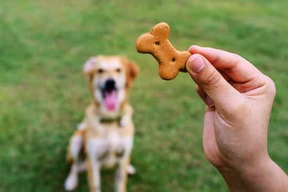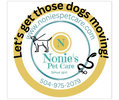Advances in veterinary diagnostics not only means dogs are now living longer and with a better quality of life than ever before, but it also means the likelihood of diagnosing cancer during a dog's life has increased. As with people, known carcinogens can have a detrimental effect on dogs (e.g., second hand smoke, exposure to ultraviolet rays, and obesity) and are associated with an increased risk of developing cancer. Cancer not only compromises a dog's quality of life, but it is also the leading cause of non-accidental death in dogs. Other diseases are more common (e.g., obesity, chronic kidney disease, allergies) but cancer remains the most common fatal disease.
0 Comments
 Many pet owners give these little extras as rewards -- or to show their love for their dogs or cats -- without thinking about the number of calories that are in each handout. Snacks like these may be one reason why more than half of pets in the U.S. weigh too much. If you want to be smart about giving your dog or cat treats, follow some guidelines to avoid adding too many calories to their diet. Limit Treats Just like cookies don’t have enough nutrients to be the bulk of your diet, pet treats aren’t healthy enough for dogs or cats to be a large part of what they eat. That’s because these products aren’t made with the same balanced nutrition that goes into the type of pet food that you serve them at mealtime. Pets shouldn’t get more than 10% of their daily calories from treats. This includes table scraps or food you might use to give your pet medicine, since these things aren’t designed for a healthy dog or cat’s diet. Your vet can tell you the total number of calories your pet needs each day, and you can figure out what 10% of that amount is. To see how many calories are in treats, look on the package. (If there are no calories listed, don’t buy that treat.) How Often to Give Treats Some people give treats to train a pet or reward good behavior. Others use them to show their love or to strengthen their bond with the animal. There’s no rule about how often you can dole them out, as long as you limit treats to 10% of their daily calories. Some owners choose to give one large biscuit each day. Others give a handful of kibble (perhaps 20 or 30 pieces) over the course of the day, one or two pieces at a time. Giving no treats is fine, too. Remember that cats and dogs do well with other rewards and signs of affection, like extra playtime with you or words of praise. Table Scraps You may like to treat your pets to a few bites from the dinner table. If you forget to count those calories in your pet’s diet, they can gain too much weight. Keep bites from the table as small as your pinky fingernail so the food doesn’t have too many calories per mouthful. Sometimes, feeding your pet table scraps can lead to begging, because they know that food can be a reward. If a pet begs and you give them food, they’ll think that it’s a reward for what they did, so they’ll beg again. If you have trouble saying no to those big eyes or whines and meows, put your pet in a different room when you eat. Or try serving them their meal at the same time that you eat yours, so they don’t feel left out. As long as you keep the portions in check, it’s fine to offer some human food to your pet. But dogs and cats should never eat:
|
Archives
July 2024
Categories |

 RSS Feed
RSS Feed